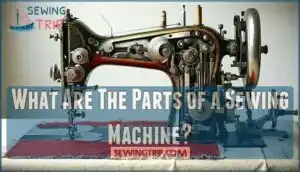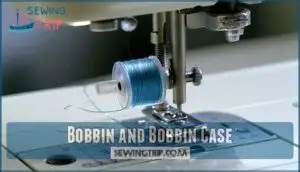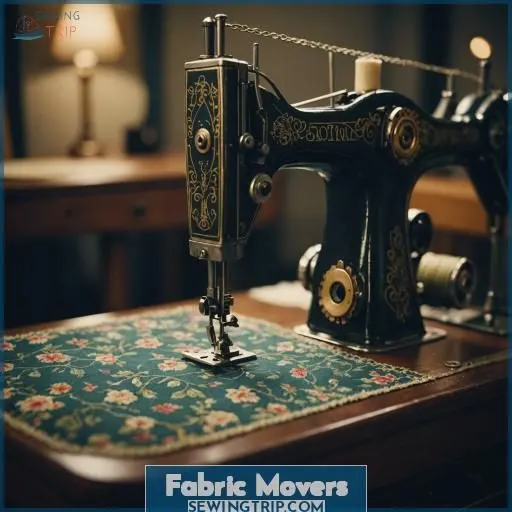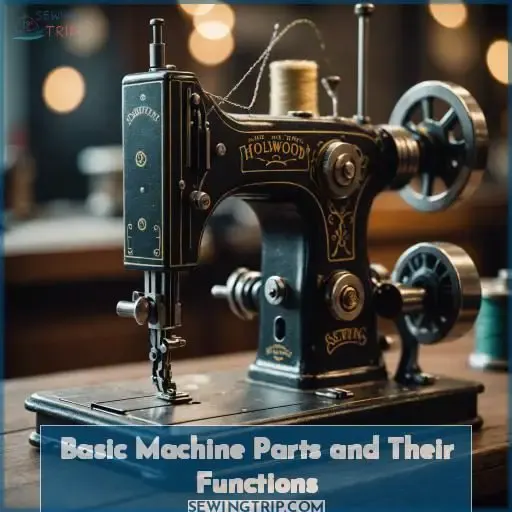This site is supported by our readers. We may earn a commission, at no cost to you, if you purchase through links.
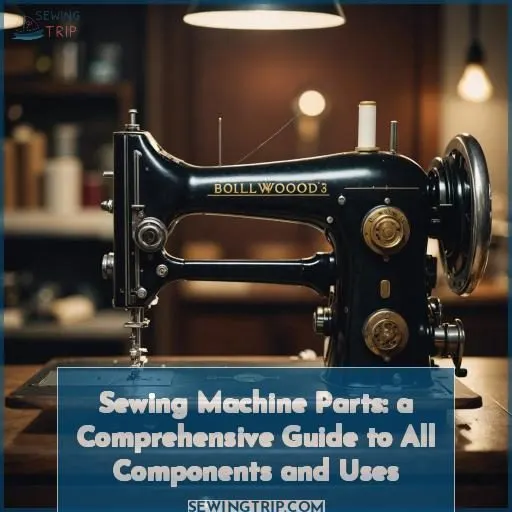
The feed dogs move fabric, controlling stitch length for smooth feeding.
The needle punctures fabric, secured by the needle clamp.
The presser foot holds fabric in place, collaborating with the throat plate which allows bobbin thread access.
Thread management involves the spool pin.
Understanding these fundamental components is key to mastering sewing.
However, there’s more to explore beyond these basics to fully grasp what the parts of a sewing machine are and how they interact seamlessly.
Table Of Contents
Key Takeaways
- The core parts of a sewing machine include the bobbin and bobbin case, feed dogs, needle and needle clamp, presser foot, and throat plate, all of which work together seamlessly to create stitches.
- Understanding the functions of these fundamental components, such as the bobbin handling the lower thread and the feed dogs controlling fabric movement, is crucial for mastering sewing.
- Proper maintenance, like regularly cleaning lint, replacing dull needles, and oiling moving parts, is essential for ensuring optimal sewing machine performance and stitch quality.
- Safety precautions, such as keeping fingers clear, securing loose clothing and hair, and unplugging the machine when threading or changing needles or bobbins, should be observed when using a sewing machine.
What Are the Parts of a Sewing Machine?
The main parts of a sewing machine include the bobbin and bobbin case, presser foot, needle and needle clamp, and throat plate.] Other key components are the fabric movers, needle, and needle plate, which work together to create stitches.
Bobbin and Bobbin Case
The bobbin and bobbin case handle the lower thread that interlocks with the upper thread to create stitches on your sewing machine. You’ll find the bobbin wound with thread in the bobbin case, which is accessed by opening the slide plate or hinged bobbin cover on the machine.
Slide Plate or Bobbin Cover
The slide plate or bobbin cover allows you to easily access the bobbin and bobbin case. It may be a sliding plate or a hinged cover, depending on your machine. These covers are typically made of plastic or metal and often have a latch or button to open them, protecting the bobbin and bobbin case while sewing.
Presser Foot
The presser foot is a critical component that secures your fabric as you sew.
It comes in various types, such as zipper, roller, and non-stick feet, each suitable for different techniques or fabrics.
Alter the presser foot pressure to accommodate different fabric thicknesses.
Preserve it by keeping it clean and free of lint.
The presser foot collaborates with the feed dogs and throat plate to ensure smooth, consistent stitching.
Needle and Needle Clamp
The needle is the sharp, pointed component that penetrates the fabric during sewing. It’s available in multiple sizes and types to suit various fabrics and methods. The needle clamp holds the needle firmly, permitting its vertical movement while the machine operates. Always keep spare needles securely and replace them frequently to maintain ideal functionality and avoid harm to your project.
Throat Plate
The throat plate is a vital component of your sewing machine. This metallic plate rests below the needle and presser foot, permitting the bobbin thread to emerge through the aperture. It bears markings for seam allowances and straight sewing, and can be detached for cleaning. Verify that the throat plate is appropriately fastened to preserve ideal tension and stitch quality.
Fabric Movers
The feed dogs are the small metal or rubber teeth that pull the fabric through the machine as you sew. They regulate the stitch length by controlling how much fabric passes under the presser foot. Make sure the feed dogs are properly aligned and the tension is correct for smooth, even feeding. If the feed dogs are worn or damaged, replace them to make certain your fabric moves through the machine efficiently.
The spool pin holds the spool of thread, while the take-up lever helps control thread tension. The foot controller, also called the foot pedal, allows you to start and stop the machine and adjust the sewing speed. Keep the spool holder clean and free of lint for consistent thread delivery. With these fabric movers working in harmony, you’ll achieve professional-looking results every time.
Basic Machine Parts and Their Functions
The needle is the part that punctures the fabric and carries the thread through, forming the stitches.
It’s held securely in place by the needle clamp, which grips the needle shaft firmly yet allows you to easily remove or replace the needle when necessary.
The needle plate is the flat surface below the needle, with markings to guide your seam allowances and openings for the needle and bobbin hook to pass through.
Needle
The needle is the workhorse of your sewing machine, punching through fabric to create stitches.
Different needle types and sizes accommodate various fabrics, from delicate silks to sturdy denim.
Keep your needles sharp and replace them regularly to maintain the best stitch quality.
Store needles safely when not in use to prevent injury.
The needle works in tandem with the pattern/stitch selector and stitch length/width controls to produce your desired stitches.
Needle Clamp
The needle clamp is the small screw that securely holds the sewing needle in place.
It’s essential to verify the needle is tightened appropriately – not too loose, which could cause the needle to shift, and not too tight, which could strip the screw threads.
Inspect your needle type, size, and compatibility with the clamp before sewing.
Avoid excessive tightening to prevent breakage.
Keep needles safely when not in use.
Needle Plate
The needle plate, also known as the throat plate, is an essential component. It sits below the needle and presser foot.
This metal plate has a small opening. The opening allows the bobbin thread to come up. The opening also allows the needle to pass through. This enables precise stitch formation.
The plate often features markings. These markings guide your fabric. The markings also help maintain consistent seam allowances.
Properly aligning the needle in the plate’s hole is vital. It is vital for thread tension. It is vital for stitch length. It is vital for sewing different fabric types.
Frequently Asked Questions (FAQs)
What are the basic parts of a sewing machine?
The basic sewing machine parts you’ll need are: needle, presser foot, bobbin case, feed dogs, throat plate, and hand wheel. Mastering these fundamentals gives you control over creating precise, professional stitches every time.
What are the 27 parts of a sewing machine?
Like a finely tuned machine, a sewing machine boasts needle, presser foot, feed dogs, bobbin case, throat plate, and tension discs – all working harmoniously to create seamless stitches.
How do I identify my sewing machine parts?
To identify your machine’s parts, consult its manual. Examine each component carefully, matching its appearance and location to the diagrams. Key parts include the presser foot, feed dogs, needle clamp, throat plate, and bobbin case. Familiarize yourself through hands-on exploration.
What are the parts of the sewing machine needle and their functions?
The needle’s main parts are the shank, shaft, groove, eye, and point. The shank secures it in the clamp. The groove guides the thread. The eye carries the thread. And the point pierces the fabric neatly.
How often should I replace the needle in my sewing machine?
Like a well-oiled machine, replacing your needle regularly—at least every 8 sewing hours—keeps your stitches looking crisp. A dull needle frays fabric faster than a soap opera drama queen tears through tissues.
Can I use different types of thread with my sewing machine?
Yes, you can use different thread types with your machine. Cotton, polyester, silk, and novelty threads are compatible. Just make sure the weight matches your needle and project.
What are some common troubleshooting tips for poor stitching?
As the saying goes, An ounce of prevention is worth a pound of cure. Check your thread tension, clean lint from the bobbin case, and replace dull needles for better stitching results.
How do I properly clean and maintain my sewing machine?
Regularly clean lint from the feed dogs, bobbin area, and needle plate using a soft brush. Oil moving parts per the manual’s instructions. Check for worn needles, and replace them often to prevent skipped stitches or damage.
Are there any safety precautions I should take when using a sewing machine?
Despite its vintage charm, heed safety – keep fingers clear, secure loose clothing and hair, unplug when threading or changing needles or bobbins.
Conclusion
Mastering the intricate components of a sewing machine empowers you to unleash its true capabilities.
With an estimated 65 million avid sewing enthusiasts worldwide, comprehending the anatomy of a sewing machine is essential.
Familiarize yourself with components like the bobbin case, feed dogs, and presser foot to achieve impeccable stitching and fabric manipulation.
Embrace this thorough guide as your gateway to sewing proficiency.

